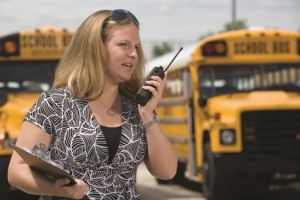
It’s a fact of life in schools these days: Kids text each other on their smartphones when they should be working on their algebra. But if a school has some kind of serious emergency, those phones suddenly become a lifeline for concerned parents. Tap in one number and they can be reassured their children are safe. That works fine until a whole school’s worth of parents tries to call in at the same time, overwhelming the local cell network.
Cellphone shortcomings are one of the key reasons why so many schools rely on
two-way radios (walkie-talkies), which operate on assigned frequencies so school staff can talk to each other quickly and easily without colliding with other wireless networks. Radios also have one-to-many capability, so the principal can say the same thing once to the entire school staff. That can’t happen with cellphones.
Economical two-way radios for schools
School districts typically have two things in common — tight budgets and busy people — placing a premium on economical, easy-to-use communication tools. BearCom sells portable two-way radios designed for this kind of scenario; and among them are the BearCom BC130 and Motorola CP200d. Both of these radios feature:
- 16 channels, so each department of a school can have its own dedicated channel.
- Up to 4 watts of power in UHF and 5 watts in VHF, which is plenty for the well-defined geography of a school.
- Easy-to-learn design with a few basic functions: a push-to-talk button, a channel selector and an on-off button that controls the volume.
- Two programmable buttons for commonly used functions.
- Rugged, industrial-strength design and water-resistant construction for indoor and outdoor use.
Advantages of the BC130
The BC130 is a bit smaller and more than five ounces lighter than the CP200d, making it a fine choice for staffers who need a more compact, lightweight unit.
The BC130 was developed for BearCom by Motorola Solutions, so you’re getting a digital radio designed and built by the industry's most trusted brand. Its low price makes it a great choice when money’s tight or when a school needs to replace a lost or broken analog radio. Keep in mind, however, that an analog radio will not have all the benefits of a digital radio.
Advantages of the CP200d
Motorola’s CP200d adds digital technology to the company’s trusted CP200 — used for years by schools and businesses the world over. Furthermore, it works in digital and analog modes, so it’s compatible with analog radios.
The underlying networking technology is perhaps the best reason to go digital. Like most computing devices, digital radios transmit packets of data that can be delivered by IP (Internet Protocol) networks. That means two key things:
- Digital voice signals can be delivered over the Internet, providing a quantum leap in a radio’s range.
- Digital data from a radio can be tracked and analyzed by school district managers to find opportunities to make school operations more efficient.
The CP200d has about 40% more battery life because digital technology uses less power. It also uses half the bandwidth of analog radios, potentially doubling the number of radios that can be used on a network. Digital radios provide clear voice communications up to the edge of their transmission range, so users do not hear more static as they move farther away from each other.
Either radio can get the job done; just remember that digital is where everything is going.

MOTOROLA, MOTOROLA SOLUTIONS and the Stylized M Logo are trademarks or registered trademarks of Motorola Trademark Holdings, LLC and are used under license. All other trademarks are the property of their respective owners. ©2015 Motorola Solutions, Inc. All rights reserved.
 It’s a fact of life in schools these days: Kids text each other on their smartphones when they should be working on their algebra. But if a school has some kind of serious emergency, those phones suddenly become a lifeline for concerned parents. Tap in one number and they can be reassured their children are safe. That works fine until a whole school’s worth of parents tries to call in at the same time, overwhelming the local cell network.
Cellphone shortcomings are one of the key reasons why so many schools rely on two-way radios (walkie-talkies), which operate on assigned frequencies so school staff can talk to each other quickly and easily without colliding with other wireless networks. Radios also have one-to-many capability, so the principal can say the same thing once to the entire school staff. That can’t happen with cellphones.
It’s a fact of life in schools these days: Kids text each other on their smartphones when they should be working on their algebra. But if a school has some kind of serious emergency, those phones suddenly become a lifeline for concerned parents. Tap in one number and they can be reassured their children are safe. That works fine until a whole school’s worth of parents tries to call in at the same time, overwhelming the local cell network.
Cellphone shortcomings are one of the key reasons why so many schools rely on two-way radios (walkie-talkies), which operate on assigned frequencies so school staff can talk to each other quickly and easily without colliding with other wireless networks. Radios also have one-to-many capability, so the principal can say the same thing once to the entire school staff. That can’t happen with cellphones.
 MOTOROLA, MOTOROLA SOLUTIONS and the Stylized M Logo are trademarks or registered trademarks of Motorola Trademark Holdings, LLC and are used under license. All other trademarks are the property of their respective owners. ©2015 Motorola Solutions, Inc. All rights reserved.
MOTOROLA, MOTOROLA SOLUTIONS and the Stylized M Logo are trademarks or registered trademarks of Motorola Trademark Holdings, LLC and are used under license. All other trademarks are the property of their respective owners. ©2015 Motorola Solutions, Inc. All rights reserved.




